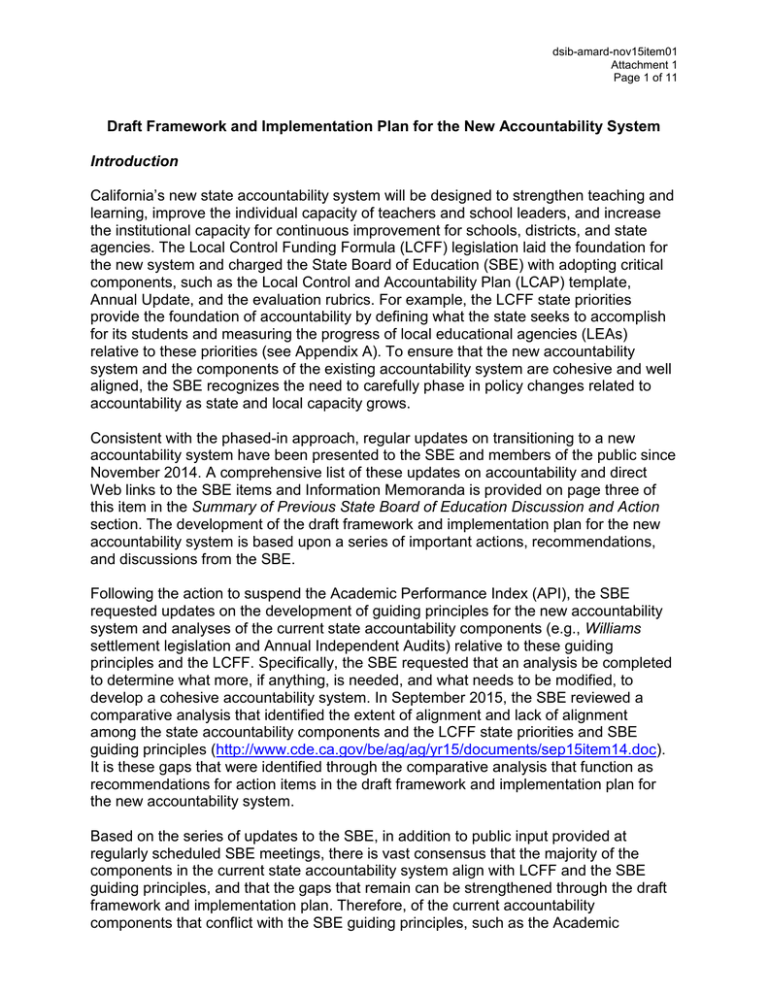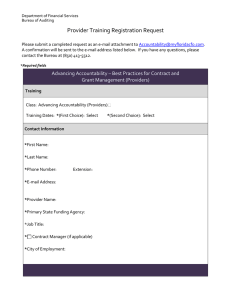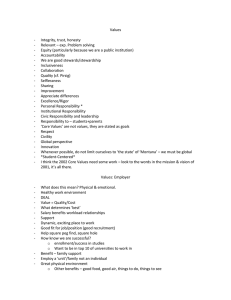Draft Framework and Implementation Plan for the New Accountability System Introduction
advertisement

dsib-amard-nov15item01 Attachment 1 Page 1 of 11 Draft Framework and Implementation Plan for the New Accountability System Introduction California’s new state accountability system will be designed to strengthen teaching and learning, improve the individual capacity of teachers and school leaders, and increase the institutional capacity for continuous improvement for schools, districts, and state agencies. The Local Control Funding Formula (LCFF) legislation laid the foundation for the new system and charged the State Board of Education (SBE) with adopting critical components, such as the Local Control and Accountability Plan (LCAP) template, Annual Update, and the evaluation rubrics. For example, the LCFF state priorities provide the foundation of accountability by defining what the state seeks to accomplish for its students and measuring the progress of local educational agencies (LEAs) relative to these priorities (see Appendix A). To ensure that the new accountability system and the components of the existing accountability system are cohesive and well aligned, the SBE recognizes the need to carefully phase in policy changes related to accountability as state and local capacity grows. Consistent with the phased-in approach, regular updates on transitioning to a new accountability system have been presented to the SBE and members of the public since November 2014. A comprehensive list of these updates on accountability and direct Web links to the SBE items and Information Memoranda is provided on page three of this item in the Summary of Previous State Board of Education Discussion and Action section. The development of the draft framework and implementation plan for the new accountability system is based upon a series of important actions, recommendations, and discussions from the SBE. Following the action to suspend the Academic Performance Index (API), the SBE requested updates on the development of guiding principles for the new accountability system and analyses of the current state accountability components (e.g., Williams settlement legislation and Annual Independent Audits) relative to these guiding principles and the LCFF. Specifically, the SBE requested that an analysis be completed to determine what more, if anything, is needed, and what needs to be modified, to develop a cohesive accountability system. In September 2015, the SBE reviewed a comparative analysis that identified the extent of alignment and lack of alignment among the state accountability components and the LCFF state priorities and SBE guiding principles (http://www.cde.ca.gov/be/ag/ag/yr15/documents/sep15item14.doc). It is these gaps that were identified through the comparative analysis that function as recommendations for action items in the draft framework and implementation plan for the new accountability system. Based on the series of updates to the SBE, in addition to public input provided at regularly scheduled SBE meetings, there is vast consensus that the majority of the components in the current state accountability system align with LCFF and the SBE guiding principles, and that the gaps that remain can be strengthened through the draft framework and implementation plan. Therefore, of the current accountability components that conflict with the SBE guiding principles, such as the Academic dsib-amard-nov15item01 Attachment 1 Page 2 of 11 Performance Index (API), the implementation plan provides recommendations to address the necessary action for modifying or eliminating these components to better align and establish a new coherent accountability system. Draft Framework and Implementation Plan Overview This draft framework and implementation plan represents another step forward in creating the new accountability system. As with any change of this magnitude, some challenges will need to be overcome as each part of the system is operationalized. However, the plan itself seeks to minimize those challenges by taking into account the research on implementation. This research identifies several key practices associated with the successful roll out of initiatives, including, but not limited to: (1) clarifying and communicating the vision for the initiative; (2) engaging critical stakeholders; (3) adopting evidence-based strategies; and (4) allowing sufficient time to implement and assess new strategies fully before engaging in any significant modifications. These and other implementation practices from the literature should be utilized when putting into practice each action item, and those identified in the years to come. The following tables depict the draft framework and implementation plan. Each table highlights: (1) a guiding principle; (2) the components that are currently in place within the existing accountability system that are applicable to that principle; (3) the action items and tasks that are necessary to fully align existing accountability components with the foundational accountability components of LCFF; (4) the coordinating agency to maintain successful implementation; and (5) the identified connections to the LCFF state priorities to establish system coherence. For the purposes of this framework and implementation plan, an Action Item is listed no more than once—in the most relevant area. The draft framework and implementation plan is not meant to answer every question, but to provide a structure for deeper action by clearly identifying the core elements and issues that need to be addressed early in developing a coherent accountability system. While the tasks and actions may seem quite clear, complex issues such as identifying valid outcome measures, developing growth models, establishing diagnostic reviews, and ensuring significant, effective interventions when needed will require a phased-in implementation approach. Thus, this draft represents phase one of the framework and implementation plan with additional action items and tasks to be phased-in later in the implementation cycle. With LEAs now responsible for more local accountability components (LCAP, Annual Update, and evaluation rubrics), purposes and roles within the new accountability system must be redefined, and will need to include cross-agency conversations and coordination. LEAs, defined as county offices of education, school districts, and charter schools, represent the entities that will be impacted by the implementation of each action item and task. The draft framework and implementation plan also depicts the big picture approach for California to strengthen and expand leadership of the state as the coordinating entity to reinforce the assistance that is necessary to implement the proposed action and move the new accountability system forward. Draft Framework and Implementation Plan–Phase I dsib-amard-nov15item01 Attachment 1 Page 3 of 11 SBE Guiding Principle: Articulate the state’s expectations for districts, charter schools and county offices of education. Current Accountability Components Local Control and Accountability Plan (LCAP) and Annual Update, and Establishing Goals Under the State Priorities County Superintendents/County Offices of Education (COEs) and the California Collaborative for Educational Excellence (CCEE) School Accountability Report Card (SARC) Williams Settlement Legislation High School Graduation Requirements Charter School Petitions Annual Independent Audits Assembly Bill (AB) 1200 Fiscal Oversight Action Items Eliminate the Academic Performance Index (API). Strengthen the understanding of standards, curriculum, and instruction. Tasks Review existing Legislation to identify the obsolete and outdated references to the API that need to be removed in order to support Legislation that will eliminate the API. Define the process to support LEAs and programs impacted by the elimination of the API. Align charter petitions, LCAPs, and Annual Updates. For example, the suspension of the API, has impacted the charter renewal process. Align SARC to include priorities 2, 7, and 8. Coordinating Entities CDE CDE CDE Strengthen technical support for LCAP and Annual Update development to include priorities 2, 7, and 8. County Offices Develop professional development modules reflecting the goals and expectations of the curricular frameworks to better ensure equitable access to high quality, rigorous instruction to prepare students to be college and career ready. CDE Strengthen the state’s expectations through technical support (e.g., high functioning systems) that emphasizes continuous improvement. CDE CCEE/ COEs Define college and career readiness. Define growth expectations for Smarter Balanced assessments. SBE/CDE/ WestEd 1Note: A description of each state priority, including the priorities that apply to county offices of education, is located in Appendix A. SBE Guiding Principle: Foster equity. Current Accountability Components State Priorities1 4,5 2,7,8,4,5 dsib-amard-nov15item01 Attachment 1 Page 4 of 11 Local Control and Accountability Plan (LCAP) and Annual Update Supplemental and Concentration Funding Focus on Increased and Improved Services for Unduplicated Students Goals for All Student Groups Technical Assistance (CDE, COE, CCEE, Charter Associations) Williams Settlement Requirements High School Graduation Requirements Action Items Tasks Develop a statewide system of support. Disaggregate data by student groups for both reporting and accountability purposes. Ensure the incorporation of and alignment across programs of effective student, family, and community engagement strategies. Make accessible current data on new collections (e.g., foster youth and homeless youth, also include gender). Coordinating Entities CDE State Priorities1 1,2,3,4,5,6, 7,8,9,10 CDE 4,5,8 Continue to support state resources (e.g., LCFF State Priorities Snapshot) and strengthen local use of data to improve instruction. Technical Assistance (TA) and practice guides will target areas of need identified by disaggregated data. Expand the understanding of student and program characteristics. Include additional indicators and metrics for CDE 1,2,3,6,7,8, elementary and middle grades, charter 9,10 schools, and alternative education programs in the LCAP and evaluation rubrics to build capacity and increase support for LEAs. 1Note: A description of each state priority, including the priorities that apply to county offices of education, is located in Appendix A. SBE Guiding Principle: Provide useful information that helps parents, districts, charter schools, county offices of education and policymakers make important decisions. Current Accountability Components Local Control and Accountability Plan (LCAP) and Annual Update dsib-amard-nov15item01 Attachment 1 Page 5 of 11 Evaluation Rubrics School Accountability Report Card (SARC) Annual Independent Audits AB 1200 Fiscal Oversight Action Items Tasks Align SARC, LCAP, e-template, Annual Update and evaluation rubrics for information and accountability purposes. Develop a data dashboard for state comparison purposes that is aligned with the research- and policy-based framework of the evaluation rubrics. Implement the Parent Engagement Frameworks. Identify how to best incorporate the Uniform Complaint Procedures (UCP), audits, waivers, and flexibility as components in the local and state partnerships for accountability purposes. Coordinating Entities CDE State Priorities1 1,2,3,4,5,6, 7,8,9,10 CDE 3 CDE 1,3 Create tools to support decision-making on evaluating strengths, weaknesses, and areas that require improvement for districts, county offices of education and charter schools. Coordinate multiple reporting functions, including SARC, LCFF Snapshots, evaluation rubrics, potential data dashboard, and DataQuest/EdData. Support LEAs in building parent engagement strategies that are embedded in schools. Determine how to best share UCP tools, resources and training modules with multiple audiences. Develop a Parent Information page on the CDE Web site to explain how to use the UCP. 1Note: A description of each state priority, including the priorities that apply to county offices of education, is located in Appendix A. SBE Guiding Principle: Build capacity and increase support for districts, charter schools and county offices. Current Accountability Components Local Control and Accountability Plan (LCAP) and Annual Update State Superintendent of Public Instruction/CDE California Collaborative for Educational Excellence County Offices of Education dsib-amard-nov15item01 Attachment 1 Page 6 of 11 Charter Associations Action Items Tasks Differentiate technical assistance. Provide multiple opportunities for deliberate practice and feedback to educators, including access to a range of meaningful practical experiences, as they learn and implement differentiated core instruction, monitor student progress, and apply evidence-based practices to meet the needs of all students within a tiered system of support. Provide the CCEE with the time and resources necessary to successfully establish its footprint as a state agency. Apply lessons learned from Fiscal Crisis & Management Assistance Team (FCMAT). Develop a robust communication exchange program to support capacity building. The CCEE will mobilize expertise in the state to help districts improve the quality of teaching and school leadership, and meet the needs of special populations. Establish a coordinated network of schools, charters, county offices of education, and state agencies to provide relevant and timely information about accountability. Coordinating Entities CDE State Priorities1 1,2,3,4,5,6, 7,8,9,10 CCEE 1,2,3,4,5,6, 7,8 CDE 1,2,3,4,5,6, 7,8,9,10 Create a regular bulletin of local and state accountability events and activities (e.g., highlights from North-South Meeting) to further strengthen local and state relationships through ongoing two-way accountability communications. 1Note: A description of each state priority, including the priorities that apply to county offices of education, is located in Appendix A. SBE Guiding Principle: Encourage continuous improvement focused on studentlevel outcomes, using multiple measures for state and local priorities. Current Accountability Components Local Control and Accountability Plan (LCAP) and Annual Update Use of Formative and Summative Assessments (e.g., State and Local Priorities Four and Eight) Community Engagement/ Parent Engagement (Priority Three) Annual Independent Audits dsib-amard-nov15item01 Attachment 1 Page 7 of 11 AB 1200 Fiscal Oversight Williams Settlement Legislation Action Items Tasks Define and implement continuous improvement in the new accountability system. Define status and growth measures. Identify resources and processes for selecting measures at the state and local levels. Use formative and summative assessments (state and local). Coordinating State Entities Priorities1 CDE 4 Include additional assessments, such as performance-based assessments, portfolio, capstones, and digital badges. CDE 2,7,8 Provide support through the evaluation rubrics on the use of the data metric selection tool to promote equity-focused actions at the district level. Support the Introduce course information (e.g., course CDE 4,5,7,8,9, inclusion of taking and performance) as a multiple 10 student measure and predictor of secondary access, course graduation and postsecondary pathway participation development. and performance in Include the State Seal of Biliteracy as a programs that measure of college and career readiness. foster college and career readiness. 1Note: A description of each state priority, including the priorities that apply to county offices of education, is located in Appendix A. SBE Guiding Principle: Promote system-wide integration and innovation. Current Accountability Components Local Control and Accountability Plan (LCAP) and Annual Update Action Items Tasks Review alignment of local, state, Identify innovative ways to align and consolidate reports and plans for local (e.g., strategic plan), state (e.g., Western Coordinating Entities CDE State Priorities1 1,2,3,4,5,6, 7,8,9,10 dsib-amard-nov15item01 Attachment 1 Page 8 of 11 and federal reports and plans to ensure equity is addressed across the plans. Association of Schools and Colleges, SARC) and federal (e.g., Title I LEA Plan/SPSA, Title II, Title III, Consolidated Application, Special Education) requirements. For example, through the electronic submission processes of the LCAP e-template, create an appendix to support LEA Plan submission. Be deliberate Test assumptions of stability in student CDE 4,8,9,10 about populations (e.g., rural, charter, and supporting the alternative schools) to support innovation. impact of innovation and Use lessons learned from LCAP continuous implementation to improve the improvement accountability system on an ongoing basis. efforts on teaching and learning to prevent unintended consequences to greater reform. 1Note: A description of each state priority, including the priorities that apply to county offices of education, is located in Appendix A. Conclusion Similar to the implementation of new assessments, new academic content standards, and a new educational finance system, the policy and implementation considerations for a new accountability system are still evolving. As the SBE reviewed in September 2015, there are a number of existing accountability components that could further align and coordinate with the LCFF and SBE guiding principles. The SBE must now consider the implications of system coherence on the development of the LCFF evaluation rubrics. Specifically, the development of the rubrics must coincide with the state’s transition to the new framework and implementation plan for the new accountability system. For example, there is a need to consider the development of the rubrics as the dsib-amard-nov15item01 Attachment 1 Page 9 of 11 state pursues the consolidation and alignment of existing reports and plans and eliminates certain vestiges of the prior system, such as the API (Attachment 1). The No Child Left Behind-era notions of accountability no longer apply, and the state is engaged in a major cultural and systems shift from a punitive system to a performancebased system that distributes resources based on student needs and expectations for performance, provides LEAs with discretion to respond to local needs and circumstances, and delivers meaningful and effective support and assistance where required. The evolving accountability system should promote, not hinder, innovation in teaching and learning and models of schooling, as well as in accountability itself. In response to these recommendations, the draft framework and implementation plan focuses on key actions that are necessary to make significant changes, reflecting each of the SBE guiding principles, and providing for evidence-based reflection to support continuous improvement practices. A phase-in approach to the action items is presented to reflect realistic deadlines and to provide ongoing reports of progress to be communicated broadly, early, and often. Thus, the draft framework and implementation plan will also function as a “living document” that enables the SBE to review and revise it periodically as the implementation of the new accountability system evolves. Regular communication on the progress of implementation will be provided through future SBE Information Memoranda and SBE meeting items. The SBE will need to continuously evaluate and improve the policy elements of the accountability system for maximum effectiveness. Continuous improvement routines may include selecting from a range of research, evaluation, and measurement options, to enrich the validity, reliability, and efficacy of the accountability system to drive progress on state goals and identify any unintended consequences. While there are several actions that will strengthen current accountability systems, that state has yet to determine what works best to drive continuous growth and improvement across all schools and districts at scale. It will take openness to judgment and innovation, with rigorous evaluation, to drive continuous improvement and the kind of dramatic improvements in student achievement that is necessary at all levels. dsib-amard-nov15item01 Attachment 1 Page 10 of 11 Appendix A Overview of LCFF State Priorities The LCFF state priorities provide the foundation of an accountability system by defining what the state seeks to accomplish for its students and measuring the progress of LEAs relative to these priorities. The LCFF clearly articulates the state priorities in the LCAP and the evaluation rubrics as specified in California EC sections 52060, 52066, and 52064.5. LEAs are expected to address each of the state priorities in their LCAPs and Annual Update, and when implemented, will rely on the evaluation rubrics to help assess program strengths and weaknesses. Charter schools must address the priorities in EC Section 52060(d) that apply to the grade levels served, or the nature of the program operated, by the charter school. The LCFF state priorities are the foundation that enable the state and LEAs to communicate progress, design assistance that is tailored to meet the needs of all students, and when necessary, guide intervention. Below is a description of each of the eight state priorities for school districts, as applicable, and for charter schools that apply to the grade levels served, or the nature of the program operated by the charter school. Priorities nine and ten only apply to county offices of education. Conditions of Learning Basic: degree to which teachers are appropriately assigned pursuant to EC Section 44258.9, and fully credentialed in the subject areas and for the pupils they are teaching; pupils have access to standards-aligned instructional materials pursuant to EC Section 60119; and school facilities are maintained in good repair pursuant to EC Section 17002(d). (Priority 1) Implementation of State Standards: implementation of academic content and performance standards and English language development standards adopted by the state board for all pupils, including English learners (ELs). (Priority 2) Course access: pupil enrollment in a broad course of study that includes all of the subject areas described in EC Section 51210 and subdivisions (a) to (i), inclusive, of Section 51220, as applicable. (Priority 7) Expelled pupils (for county offices of education only): coordination of instruction of expelled pupils pursuant to EC Section 48926. (Priority 9) Foster youth (for county offices of education only): coordination of services, including working with the county child welfare agency to share information, responding to the needs of the juvenile court system, and ensuring transfer of health and education records. (Priority 10) Pupil Outcomes Pupil achievement: performance on standardized tests, score on API, share of pupils that are college and career ready, share of ELs that become English proficient, EL reclassification rate, share of pupils that pass Advanced Placement exams with 3 or higher, share of pupils determined prepared for college by the Early Assessment Program. (Priority 4) Other pupil outcomes: pupil outcomes in the subject areas described in EC Section 51210 and subdivisions (a) to (i), inclusive, of EC Section 51220, as applicable. (Priority 8) dsib-amard-nov15item01 Attachment 1 Page 11 of 11 Engagement Parental involvement: efforts to seek parent input in decision making at the district and each schoolsite, promotion of parent participation in programs for unduplicated pupils and special need subgroups. (Priority 3) Pupil engagement: school attendance rates, chronic absenteeism rates, middle school dropout rates, high school dropout rates, high school graduations rates. (Priority 5) School climate: pupil suspension rates, pupil expulsion rates, other local measures including surveys of pupils, parents and teachers on the sense of safety and school connectedness. (Priority 6) 10-23-15 [State Board of Education] dsib-amard-nov15item01 Attachment 1 Page 12 of 11



